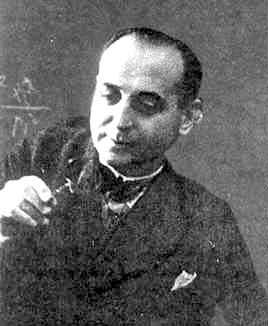


 تاريخ الرياضيات
تاريخ الرياضيات
 الرياضيات في الحضارات المختلفة
الرياضيات في الحضارات المختلفة 
 الرياضيات المتقطعة
الرياضيات المتقطعة
 الجبر
الجبر
 الهندسة
الهندسة 
 المعادلات التفاضلية و التكاملية
المعادلات التفاضلية و التكاملية 
 التحليل
التحليل
 علماء الرياضيات
علماء الرياضيات |
Read More
Date: 27-7-2017
Date: 18-7-2017
Date: 25-7-2017
|
Died: 25 April 1945 in Wechselburg, Sachsen, Germany

Georg Feigl's father, who earned his living importing goods, was also named Georg Feigl. Georg's mother, Maria Pinl was from Bohemia. When Georg was born his father was 41 years old and his mother was 27. He attended school (the Johanneum) in Hamburg then, in 1909, he began his studies at the University of Jena. Due to ill health his study of mathematics and physics took longer than expected and a severe chronic stomach problem forced him to interrupt his work on several occasions. He obtained a degree from Jena taking much longer than was normal because of his health problems, then in 1919 he obtained a doctorate from Jena working under Koebe. His doctoral dissertation was on conformal mappings.
In 1919 Feigl became a budgeted assistant of Schmidt at the Mathematical Institute of the University of Berlin. Feigl's later research and teaching were both greatly influenced by Schmidt. Rohrbach writes in [1]:-
Generations of students in mathematics at the University of Berlin took the introductory course "Einführung in die höhere Mathematik" which Feigl created and which after his death was published, in enlarged form, as a textbook (1953) by Hans Rohrbach.
In 1925 Feigl became managing editor of the journal Jahrbuch über Fortschritte der Mathematik, the only reviewing journal at that time, which was produced in Berlin by the Prussian Academy of Sciences. In the same year Feigl married Maria Fleischer, the daughter of Paul Fleischer who was an economist. Feigl's mother died two years after his marriage, and his father died four years later.
Promotion at Berlin came steadily for Feigl who was promoted in 1927 and then again to extraordinary professor in 1933. Two years later, in 1935, Feigl was appointed to the Chair of Mathematics at the University of Breslau where he was head of the Department. In [3] Pinl explains that in Breslau:-
... his aim was the building up and heading the Mathematical Institute through lectures, supervision of doctorates and habilitations, cooperation with the Reich Association of German Mathematical Societies and Clubs and participation in managerial and scientific tasks for the German Experimental Institution for Aeronautics.
Feigl wrote to several of his colleagues on 30 May 1935 asking for their cooperation in setting up a new mathematics journal, the Neue Deutsche Forschungen. Feigl wanted Süss from Freiburg, Hamel from Berlin, Koebe from Leipzig, Kowalewski from Dresden and Tornier from Göttingen to cooperate within the Mathematics Department of the Reich Research Council and help him identify doctoral dissertations which would be suitable for publication. Feigl explained in his letter to Süss, written on 30 May, that he was embarrassed by the fact that Compositio Mathematica was publishing so many works by non-Aryans.
In 1941 Feigl was elected onto the Executive Committee of the German Mathematical Society. He worked with colleagues such as Behnke, Süss and Hamel on the Instruction Commission of the German Mathematical Society, becoming head of the Commission. Mostly due to his health problems he had been forced to decide between concentrating on research or teaching, and he had decided to concentrate on the latter. He was therefore a natural choice to head the Instruction Commission both because of his interests and also because of his expertise.
Although he had accepted the direction that the Nazis had taken Germany, Feigl was strongly opposed to Hitler and his regime so became increasingly alarmed when fellow mathematicians were arrested by the Gestapo. He wrote to Süss expressing his worries when Ernst Mohr was arrested in 1944 but Süss reassured him that Mohr had been careless (Mohr's crime seemed to have been that he had listened to the BBC).
In February 1944 Feigl had been ordered to report for active duty in the German army as an anti-aircraft gunner. With the help of Süss, who supported him on behalf of the Reich Research Council, he successfully won exemption. Later that year he offered to cooperate on work with the military, by using the resources of his Mathematical Institute. The centre of Breslau was bombed on 7 October 1944 but the Mathematical Institute was essentially undamaged (only 4 panes of glass were broken). At this time Feigl was working with Schmidt on a book on differential and integral calculus. Feigl had been lecturing on this topic and his lectures were used as the basis for the book on which they worked. The manuscript of the book was, sadly, lost during the final stages of the war. Feigl's wife Maria said that it had been stolen by Poles in the county of Glatz (today Klodzko). By January 1945 the Russian army was advancing towards Breslau and a decision was taken to move the mathematicians from the city. In February Feigl and his colleagues moved the Mathematical Institute from Breslau to Schönburg Castle at Wechselburg, not far from Leipzig. However, Feigl had required constant medication all through his life for his stomach condition and, not being able to obtain his medication at Wechselburg led to his death within a couple of months.
Feigl worked on geometry, in particular the foundations of geometry and topology. He was mainly interested in teaching, however, and he introduced many teaching reforms. Through him the modern approach of Hilbert and Klein was introduced into universities and even into secondary schools.
Articles:



|
|
|
|
للعاملين في الليل.. حيلة صحية تجنبكم خطر هذا النوع من العمل
|
|
|
|
|
|
|
"ناسا" تحتفي برائد الفضاء السوفياتي يوري غاغارين
|
|
|
|
|
|
|
نحو شراكة وطنية متكاملة.. الأمين العام للعتبة الحسينية يبحث مع وكيل وزارة الخارجية آفاق التعاون المؤسسي
|
|
|